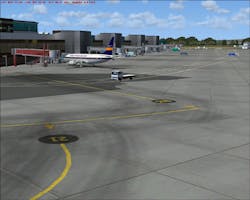As I crisscrossed the country this past week – from Boston’s BOS to New York’s LGA and later that same day from JFK to LAX – I couldn’t help but notice how some airports or airlines do a much better job of marking the ramp area than others. While all the runway and taxiway lines were clear and bright, that was not at all the case with a number of ramp areas I observed on my travels. Even during the daylight hours, some lines were so faded that they probably would have been nearly invisible in any kind of foul weather. That is not a good thing, if we want to protect our GSE and aircraft from ground damage.
Clearly delineated and visible markings for equipment positioning can and have reduced ground damage. If that’s not enough of an incentive – although it certainly should be given the costs of ground damage to both GSE and aircraft – clear markings also contribute to a more efficient operation. And efficiency always saves time and money. When you take the guesswork out of positioning equipment, the operation can flow more smoothly.
And for all those passengers observing the ramp from inside terminals or aircraft, clear, bright lines and equipment placed within the lines give a professional appearance. And professional appearances are reassuring to all of us




